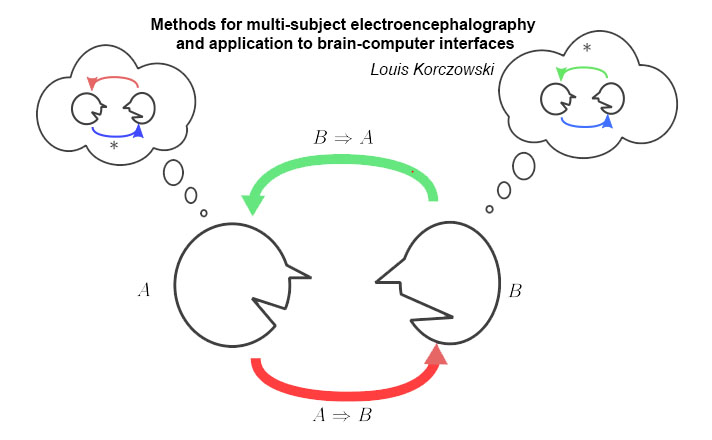I am really proud to announce the public defense of my thesis work (provided that I have the approval of the reviewers).
Methods for multi-subject electroencephalography and application to brain-computer interfaces
Wednesday, October 17th 2018 at 10:00
Location: Salle Mont-Blanc, GIPSA-lab, Bat. D Ampère 1er étage, 11 rue des mathématiques, 38400 Saint-Martin-d’Hères, France.
Access: Tram B & C, Arrêt Gabriel Fauré. openstreetmap
It will be followed by a buffet around 12:30.
The defense is a public presentation (45 min) followed by questions from the jury. The defense will be in french, however a short summary in english will be released in the following month of the thesis (or see publications). Meanwhile, you can have a glimpse of the presented work with the abstract below.
Methods for multi-subject electroencephalography and application to brain-computer interfaces
by Louis Korczowski, under the supervision of Christian Jutten and Marco Congedo
Abstrast– The study of several brains interacting (hyperscanning) with neuroimagery allows to extend our understanding of social neurosciences.
We propose a framework for hyperscanning using multi-user Brain-Computer Interfaces (BCI) that includes several social paradigms such as cooperation or competition.
This dissertation includes three interdependent contribution.The first contribution is the development of an experimental platform consisting of a multi-player video game, namely Brain Invaders 2, controlled by classification of visual event related potentials (ERP) recorded by electroencephalography (EEG).
The platform is validated through two experimental protocols including nineteen and twenty two pairs of subjects while using different adaptive classification approaches using Riemannian geometry.Those approaches are theoretically and experimentally compared during the second contribution ; we demonstrates the superiority in term of accuracy of merging independent classifications over the classification of the hyperbrain during the second contribution.
Analysis of inter-brain synchronizations is a common approach for hyperscanning, however it is challenging for transient EEG waves with an great spatio-temporal variability (intra- and inter-subject) and with low signal-to-noise ratio such as ERP.
Therefore, as third contribution, we propose a new blind source separation model, namely composite model, to extract simultaneously evoked EEG sources and ongoing EEG sources that allows to compensate this variability.
A solution using approximate joint diagonalization is given and implemented with a fast Jacobi-like algorithm.We demonstrate on Brain Invaders 2 data that our solution extracts simultaneously evoked and ongoing EEG sources and performs better in term of accuracy and robustness compared to the existing models.
keywords : Electroencephalogram (EEG), Blind Source Separation (BSS), Hyperscanning, Classification, Brain-Computer Interface (BCI), Event-Related Potential (ERP)
